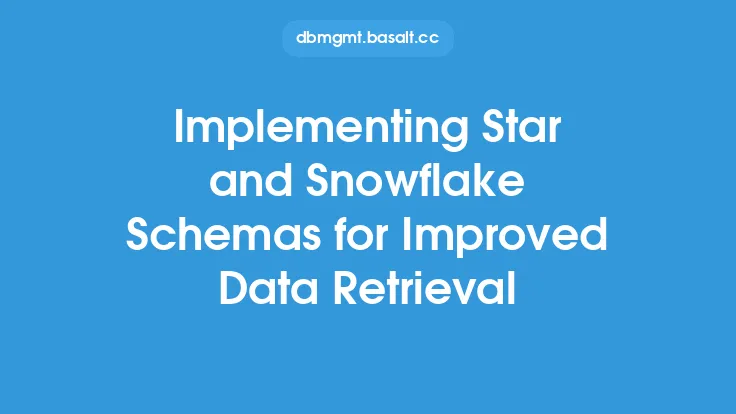Data modeling is a crucial step in the development of a data warehouse, as it enables organizations to design a robust and scalable architecture that meets their business intelligence needs. When it comes to data modeling for data warehousing, two popular schema designs are widely used: star and snowflake schemas. In this article, we will delve into the details of these two schema designs, exploring their characteristics, advantages, and use cases.
Introduction to Star Schemas
A star schema is a type of data warehouse schema that consists of a central fact table surrounded by dimension tables. The fact table contains measurable data, such as sales amounts or website traffic, while the dimension tables provide context to the fact data, such as date, customer, or product information. The star schema is called as such because the dimension tables are connected to the fact table like the points of a star. This design is ideal for querying and analyzing data, as it allows for fast and efficient data retrieval.
Characteristics of Star Schemas
Star schemas have several key characteristics that make them suitable for data warehousing. Firstly, the fact table is denormalized, meaning that it contains redundant data to improve query performance. Secondly, the dimension tables are normalized, which helps to reduce data redundancy and improve data integrity. Thirdly, the star schema uses a single fact table, which simplifies data querying and analysis. Finally, the dimension tables are typically small and static, which makes them easy to manage and maintain.
Advantages of Star Schemas
Star schemas offer several advantages over other schema designs. Firstly, they provide fast query performance, as the fact table is denormalized and the dimension tables are small and static. Secondly, they are easy to maintain, as the dimension tables are normalized and the fact table is simple to update. Thirdly, star schemas are scalable, as they can handle large amounts of data and support high-performance querying. Finally, they are flexible, as they can be easily extended to support new business requirements.
Introduction to Snowflake Schemas
A snowflake schema is a type of data warehouse schema that extends the star schema design by adding additional dimension tables. In a snowflake schema, each dimension table is connected to another dimension table, forming a hierarchical structure. This design is more complex than the star schema, but it provides greater flexibility and scalability. Snowflake schemas are ideal for organizations with complex business requirements, as they can handle large amounts of data and support advanced analytics.
Characteristics of Snowflake Schemas
Snowflake schemas have several key characteristics that distinguish them from star schemas. Firstly, the dimension tables are connected to each other, forming a hierarchical structure. Secondly, the snowflake schema uses multiple fact tables, which can improve query performance and support advanced analytics. Thirdly, the dimension tables are normalized, which helps to reduce data redundancy and improve data integrity. Finally, the snowflake schema is more complex than the star schema, which can make it more challenging to maintain and manage.
Advantages of Snowflake Schemas
Snowflake schemas offer several advantages over star schemas. Firstly, they provide greater flexibility, as they can handle complex business requirements and support advanced analytics. Secondly, they are more scalable, as they can handle large amounts of data and support high-performance querying. Thirdly, snowflake schemas are more suitable for organizations with complex data structures, as they can handle hierarchical data relationships. Finally, they provide better data integrity, as the dimension tables are normalized and the fact tables are denormalized.
Comparison of Star and Snowflake Schemas
Star and snowflake schemas have different design principles and use cases. Star schemas are ideal for simple data structures and fast query performance, while snowflake schemas are suitable for complex data structures and advanced analytics. Star schemas are easier to maintain and manage, while snowflake schemas are more challenging due to their complexity. In terms of scalability, both star and snowflake schemas can handle large amounts of data, but snowflake schemas are more suitable for organizations with complex business requirements.
Best Practices for Implementing Star and Snowflake Schemas
When implementing star and snowflake schemas, there are several best practices to follow. Firstly, define the business requirements and identify the key performance indicators (KPIs) that need to be measured. Secondly, design the fact table to include all the necessary metrics and dimensions. Thirdly, normalize the dimension tables to reduce data redundancy and improve data integrity. Fourthly, use a data modeling tool to design and implement the schema. Finally, test and validate the schema to ensure that it meets the business requirements and performs well.
Common Challenges and Solutions
When implementing star and snowflake schemas, there are several common challenges that can arise. Firstly, data redundancy can occur if the dimension tables are not properly normalized. Secondly, query performance can be slow if the fact table is not properly denormalized. Thirdly, data integrity can be compromised if the dimension tables are not properly maintained. To overcome these challenges, it is essential to follow best practices, use data modeling tools, and test and validate the schema regularly.
Conclusion
In conclusion, star and snowflake schemas are two popular schema designs used in data warehousing. Star schemas are ideal for simple data structures and fast query performance, while snowflake schemas are suitable for complex data structures and advanced analytics. By understanding the characteristics, advantages, and use cases of these schema designs, organizations can design a robust and scalable data warehouse that meets their business intelligence needs. By following best practices and using data modeling tools, organizations can ensure that their data warehouse is well-designed, scalable, and performs well.





